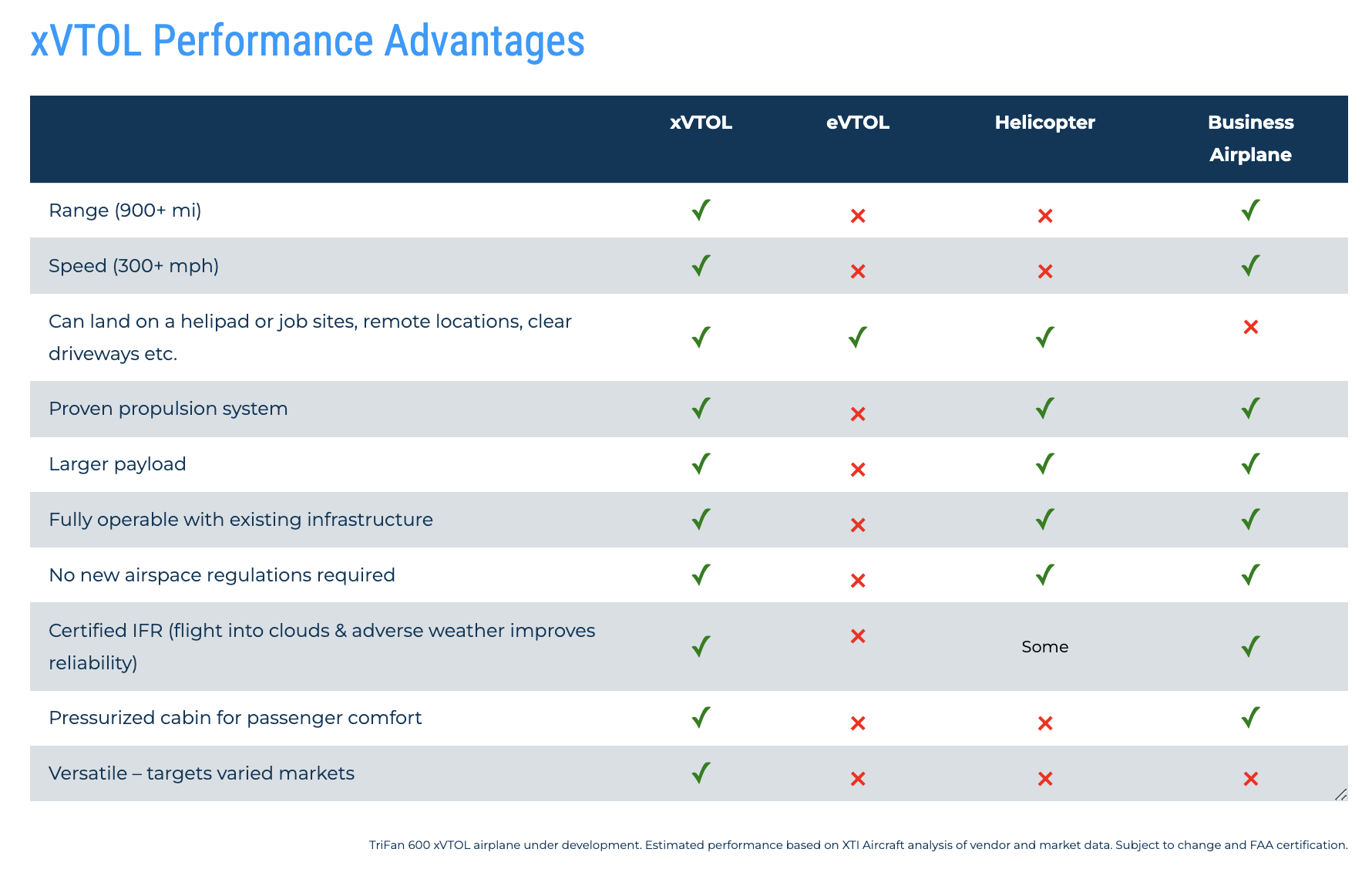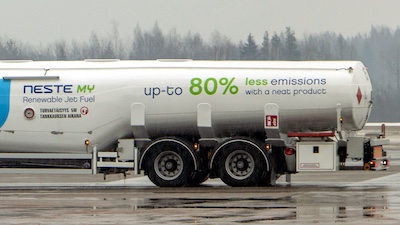XTI’s Pragmatic Path to Sustainable Vertical Lift
Most media attention in the vertical takeoff and landing (VTOL) segment of the developing advanced air mobility (AAM) sector of aviation is focused on battery-powered electric VTOL (eVTOL) aircraft OEMs, such as Joby Aviation, Archer Aviation, and Eve Air Mobility. Their target market is short-range missions that can be conducted in generally good weather conditions. This is due to current battery limitations and the relatively minor improvements that are forecasted for energy density (about 4-5% a year).
In contrast, XTI Aerospace targets the business aviation, air medical, cargo, and military markets, currently served by both fixed-wing aircraft and helicopters, which require longer range and higher payloads, and must operate in all weather and icing conditions. These requirements cannot be met by today’s battery technology. Therefore XTI has chosen a different path than that pursued by the eVTOL OEMs.
TriFan Attributes and Market
 The majority of the busiest business aircraft routes in the U.S and Europe are less than 400 miles (e.g., Los Angeles to Las Vegas, New York to Washington DC, London to Paris, Geneva to Nice, etc.). With its planned VTOL range of over 950 miles (1500 km) and the ability to carry up to 6 passengers, XTI’s TriFan 600 will effectively cater to this large market, while saving customers time by operating point-to-point from helipads, parking lots, roads, backyards – wherever it’s safe and legal. For example, in air medical operations, with its ability to operate at over twice the speed and range of competing helicopters, transporting critical patients at 25,000 ft. in pressurized comfort at a fast 311 mph (500 kph) non-stop to the optimal medical facility up to 950 miles away, the TriFan 600 has the potential to significantly enhance emergency services delivery.
The majority of the busiest business aircraft routes in the U.S and Europe are less than 400 miles (e.g., Los Angeles to Las Vegas, New York to Washington DC, London to Paris, Geneva to Nice, etc.). With its planned VTOL range of over 950 miles (1500 km) and the ability to carry up to 6 passengers, XTI’s TriFan 600 will effectively cater to this large market, while saving customers time by operating point-to-point from helipads, parking lots, roads, backyards – wherever it’s safe and legal. For example, in air medical operations, with its ability to operate at over twice the speed and range of competing helicopters, transporting critical patients at 25,000 ft. in pressurized comfort at a fast 311 mph (500 kph) non-stop to the optimal medical facility up to 950 miles away, the TriFan 600 has the potential to significantly enhance emergency services delivery.
In addition to being able to take off and land vertically, the TriFan will have the added flexibility to also take off from very short and longer runways, increasing payload and extending range. It will be certified for inclement weather operations (Instrument Flight Rules (IFR) including known icing conditions. This is critical for XTI’s target customers.
The combination of these attributes in a single aircraft is unique in civil aviation. By combining VTOL, long range and all-weather flight, XTI’s TriFan can effectively replace two aircraft – a fixed-wing airplane and a helicopter. Thus, the TriFan establishes a new category of aircraft — xVTOL, with extended capabilities and an expanded scope of operational possibilities, especially compared to eVTOLs.

Sustainability Path
XTI is committed to taking aviation to a greener future. It is generally accepted in the industry that batteries alone, at least in the next decade or two, will not be capable of serving long-range, high-speed VTOL missions. This reality led XTI to evaluate using hybrid-electric propulsion solutions for several years, first with batteries and then with hydrogen fuel cells. We concluded that the following factors were likely to result in delays in service entry when specifically considering our targeted VTOL missions:
- Technical readiness of batteries or hydrogen for longer-range, fast VTOL missions.
- Regulatory uncertainties around certifying novel propulsion technologies for airplanes.
- Slow rollout of the charging infrastructure, which will limit usable route networks.
We therefore chose a phased approach to sustainability:
 Start with two turboshaft engines capable of burning 100% sustainable aviation fuel (SAF, from non-fossil sources), the use of which can reduce CO2 emissions by 80%.
Start with two turboshaft engines capable of burning 100% sustainable aviation fuel (SAF, from non-fossil sources), the use of which can reduce CO2 emissions by 80%.- Monitor progress and development of the limiting factors noted earlier and evaluate switching to hybrid-electric propulsion when appropriate.
- Switch to all-electric propulsion when our mission can be accomplished solely by electric power.
This phased approach allows the systematic development of green energy solutions while initially focusing on certifying the other critical elements of a long-range, fast VTOL airplane.
In our judgment, this strategy is the most expeditious path to useful sustainability. It considerably de-risks the TriFan development program and allows XTI to more quickly bring a very unique airplane to a much larger market.
In conclusion, the TriFan 600 xVTOL exemplifies XTI’s commitment to pioneering sustainable vertical lift aviation through a phased approach. By balancing operational needs with evolving technological advancements, XTI is poised to deliver a unique, high-performance aircraft that meets market demands while progressively moving toward a greener future.
Author: Saleem Zaheer, Chief Commercial Officer, XTI Aerospace
